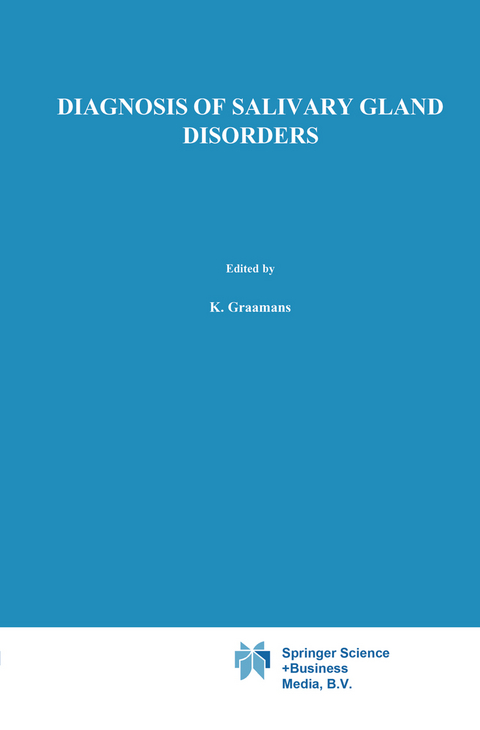
Diagnosis of salivary gland disorders
Springer (Verlag)
978-94-010-5600-7 (ISBN)
Historically, disorders of salivary glands tend to be 'underdiagnosed and overtreated'. In the vast body of literature on this subject, emphasis has usually been put on therapeutic modalities of various diseases of the salivary glands. Whereas therapy and pathology have been treated in numerous thorough studies, the (patho )physiology of the salivary glands has remained rather poorly understood. Even less attention has been given to the diagnostic methods. Until a few decades ago, diagnosis consisted mainly of a clinical examin ation which included the patient's history, inspection, and palpation. These methods remain crucial, but a variety of new diagnostic tools have appeared since then. Their clinical value is still subject to controversy; each method has its advocates and opponents. The indications for enrolling a patient at a given point in a series of diagnostic procedures are interpreted differently. One of the most striking examples is the use of sialography. This has become a classic diagnostic procedure. Although sialography is still a useful method, it has considerable disadvantages, limitations, and even contraindications. In the major teaching hospitals, residents still tend to consider sialography as a panacea for the majority of their diagnostic problems, whereas the infor mation provided is actually rather restricted. Other modern methods such as CT and MRI have taken over the role of sialography to a certain extent. This also applies to ultrasonography and scintigraphy. Moreover, microbiol ogy, sialometry, sialochemistry, cytology, and histopathology may give super ior information in certain cases.
1. History and physical examination.- 1. Introduction.- 2. History.- 3. Physical examination.- 4. Further considerations.- 2. Plain radiography and sialography.- 1. Introduction.- 2. Plain radiography.- 3. Sialolithiasis.- 4. Inflammatory disorders.- 5. Sialadenosis.- 6. Tumors and space-occupying lesions.- 7. Miscellaneous disorders.- 8. Conclusion.- References.- 3. Computed tomography of the major salivary glands.- 1. Introduction.- 2. CT versus CT-sialography of the parotid and submandibular gland.- 3. Technique.- 4. CT-sialography.- 5. CT anatomy.- 6. CT appearance of salivary gland tumors.- References.- 4. Magnetic resonance imaging of the parotid gland.- 1. Introduction.- 2. Some remarks on MRI.- 3. Normal anatomy.- 4. Pathology.- 5. MRI in parotid disease.- 6. Conclusions.- References.- 5. Ultrasound in salivary gland disease.- 1. Introduction.- 2. Ultrasound imaging principles.- 3. Ultrasound examination of the salivary glands.- 4. Inflammatory disease.- 5. Space-occupying lesions.- 6. Diagnostic ultrasound in salivary gland disease.- 7. Conclusion.- References.- 6. Salivary gland scintigraphy with 99mTc-pertechnetate.- 1. Introduction.- 2. Scintigraphic method.- 3. Normal images and time-activity curves.- 4. Tumors.- 5. Sialadenitis and sialolithiasis.- 6. Sjögren’s syndrome.- 7. Sialadenosis.- 8. Miscellaneous disorders.- 9. Conclusion.- References.- 7. Fine-needle aspiration cytology.- 1. Introduction.- 2. Technique of FNA.- 3. Conditions for optimum FNA results.- 4. Complications of FNA.- 5. Reliability of FNA.- 6. Interpretation.- 7. FNA of salivary glands: cytological features.- 8. Pitfalls in cytodiagnosis.- 9. Conclusion.- References.- 8. Histopathologic diagnosis of salivary gland disorders.- 1. Introduction.- 2. Histology.- 3. Histopathology.-References.- 9. Microbiology of salivary gland infections.- 1. Introduction.- 2. Overview of salivary gland infections.- 3. Diagnosis of viral and bacterial infections of the salivary glands.- 4. Conclusion.- References.- 10. Sialometry and sialochemistry.- 1. Introduction.- 2. Salivary secretion.- 3. The collection of saliva.- 4. Sialometry.- 5. Sialochemistry.- 6. Blood chemistry.- 7. Diagnostic aids to salivary gland disease.- 8. Irradiation.- 9. Sodium retention dysfunction syndrome.- 10. Sialadenosis.- 11. Salivary gland disease in terminal illness.- 12. Tumors of the salivary glands.- 13. The effects of drugs.- 14. Conclusion.- References.- 11. Concluding remarks and recommendations.- 1. Introduction.- 2. Major salivary glands.- 3. Accessory salivary glands.- References.- Index of subjects.
| Zusatzinfo | XIV, 175 p. |
|---|---|
| Verlagsort | Dordrecht |
| Sprache | englisch |
| Maße | 155 x 235 mm |
| Themenwelt | Medizin / Pharmazie ► Medizinische Fachgebiete ► Chirurgie |
| Medizin / Pharmazie ► Medizinische Fachgebiete ► HNO-Heilkunde | |
| Medizinische Fachgebiete ► Innere Medizin ► Gastroenterologie | |
| Medizin / Pharmazie ► Medizinische Fachgebiete ► Onkologie | |
| Medizinische Fachgebiete ► Radiologie / Bildgebende Verfahren ► Radiologie | |
| ISBN-10 | 94-010-5600-5 / 9401056005 |
| ISBN-13 | 978-94-010-5600-7 / 9789401056007 |
| Zustand | Neuware |
| Haben Sie eine Frage zum Produkt? |
aus dem Bereich


